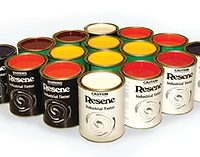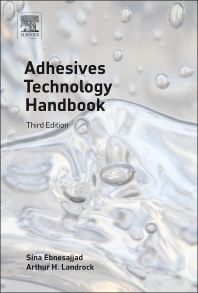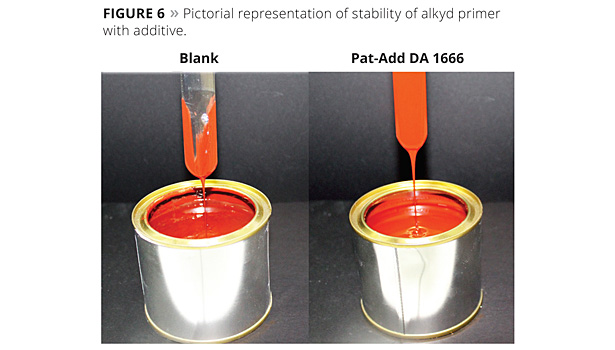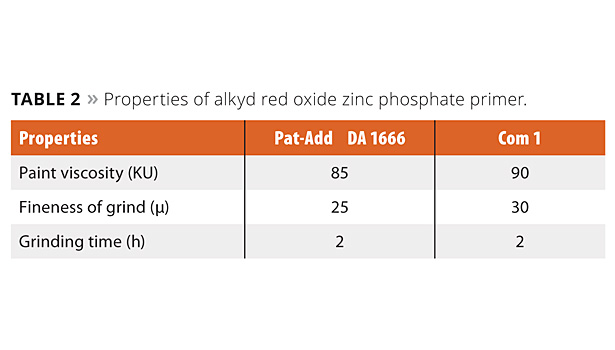A Multipurpose Additive for Solventborne Coatings


















Paint formulations consist of binders, pigments, solvents and additives, in which additives play a very important role, even at low dosages. Each additive has a functional importance in the final coating. Some of the main properties additives achieve are wetting and dispersion, defoaming, anti-settling, anti-sagging, and flow and leveling.
Since some additives are sought after for a specific function, paint manufacturers may find themselves working with many different additives. Indirect problems that result from this include controlling inventory, monitoring quality parameters, increased cost, etc. This led researchers to develop multipurpose additives that can achieve many of the desired properties in one product – thus eliminating many of the problems listed above.
Pat-Add DA 1666 is the result of such efforts. It offers a sustainable solution, multi-functional performance and compatibility with different solventborne systems.
Multipurpose Additive
Pat-Add DA 1666 is a pigment wetting and dispersing additive for solventborne architectural and industrial paints. It is also utilized as a polar activator to provide excellent gelling in organophilic bentonites, as well as a compatibilizer, an anti-sagging agent and an anti-settling agent. This polymeric dispersing agent shows very high compatibility with various binders in solventborne systems, including polyurethane, epoxy and alkyd systems.
Key Features
This additive offers several key features, including: excellent wetting and dispersing for fillers, inorganic, organic, and reactive pigments like zinc oxide, and it's an efficient dispersant for grinding pigments at temperatures as low as 15 °C. It also offers reduced mill base viscosity and milling time; acts as a compatibilizer; has good anti-sagging properties and eliminates settling, thereby enhancing stability.
Performance Studies
Efficient Dispersing Agent
Pat-Add DA 1666 has efficient pigment affinity groups that adsorb on various types of pigments such as reactive, inorganic, organic and fillers. The dispersant reduces the mill base viscosity, enhances particle size reduction and reduces the milling time. It can work in small dosages and provides low mill base viscosity, optimum color strength, hiding power, improved film gloss and efficient low-temperature grinding (from 15 °C).
2K PU Red Oxide Zinc Phosphate Primer
This multipurpose additive showed excellent wetting and dispersion of pigments in a 2K PU primer with zinc phosphate pigments. Results show a lowering of mill base viscosity and a reduction in grinding time (Table 1).
Alkyd Red Oxide Zinc Phosphate Primer
The additive has good compatibility with alkyd resins, facilitates wetting and dispersion of pigments, and provides low mill base viscosity and milling time (Table 2).
Topcoat System
Excellent results with alkyd, epoxy and PU direct grinding systems are also achieved using this additive due to their excellent compatibility. Figure 1 shows that white paint made using this additive in different resin systems gives better brightness, low yellow index and good gloss values.
The same trend of higher brightness, low yellow index and good gloss values was also observed for alkyd and epoxy paints. Viscosity studies show that Pat-Add DA 1666 has the ability to reduce the mill base viscosity and improve the grinding efficiency (Table 3).
Flotation
This additive also addresses pigment flotation. In a co-grinding system, different types of pigments are used to produce colored paint, such as organic, inorganic and black pigments. Strong pigment affinity groups on the multifunctional additive hinder pigment agglomeration and prevent flotation (Figure 2).
Compatibilizer
Improper compatibility between colorants and paints result in pigment separation from the binder system, which leads to poor color development and pigment flocculation during film formation. Figure 3 depicts the co-grinding of black and white pigments in a PU system with flocculation, and the role of Pat Add DA 1666 as a compatibilizer.
The additive occupies the adsorptive sites on the pigment/extender, thus preventing a loss of stabilizer from the colorant and creating good compatibility with the paint system. The detailed mechanism is depicted in Figure 4.
Anti-Sagging
The multifunctional and muticompatible additive offers anti-sagging properties in epoxy, PU, alkyd and other solventborne paints and applications. Even though it has lower viscosity than the conventional additive sample shown in Figure 5, it provides good anti-sagging properties to the paint.
Long-Term Stability
Test results with an alkyd primer show that this new additive has no separation and settling in primer, and it provides excellent long-term storage stability of paints. Pigment affinity groups present in the additive allow easy anchoring of pigments and form a strong bond with them, thereby providing excellent stability to the paint (Figure 6).
Conclusion
Based on test results, Pat-Add DA 1666 takes paint properties to a higher level. It maximizes the wetting and dispersion of pigments for various solventborne systems, provides good anti-sagging properties, eliminates settling and enhances stability. Incorporating this additive enhances the properties and performance of anticorrosive primer coatings and solves the issues of flocculation and color development. These features make Pat-Add DA 1666 a promising additive for solventborne coatings, with potential cost savings and a one-stop solution without inventory-related hurdles.
For more information, visit www.patchamltd.com.
By Bhagath Singh W., Arpit Makwana and Biren Patel, PATCHAM (FZC), Sharjah, UAE
Looking for a reprint of this article?
From high-res PDFs to custom plaques, order your copy today!


















